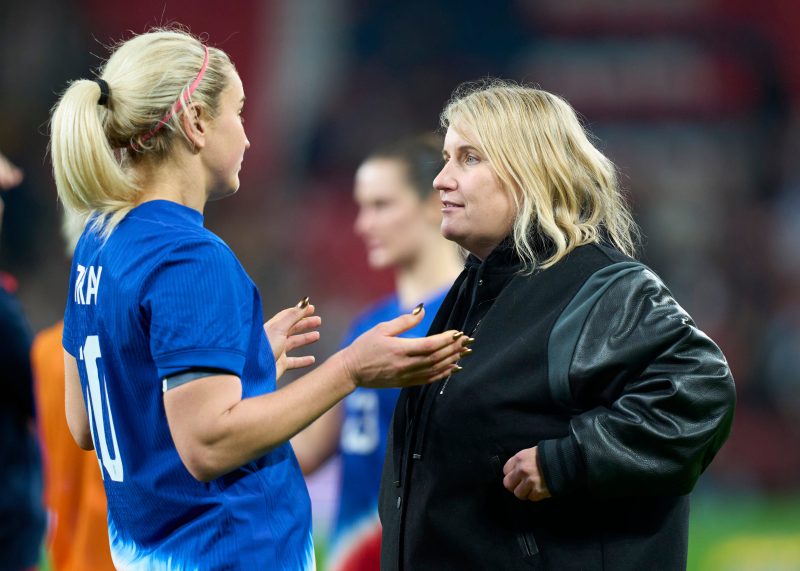
Emma Hayes has had enough of crash-test dummies.
See, researchers have found the dummies used in safety tests are at least partly to blame for women being more likely to die or be injured in car crashes. The dummies have, for decades, been modeled on the male body even though women are typically shorter and smaller, with lower bone density and different muscle mass distribution.
Which means the seat belt that hits bone on a man is more likely to slide up on a woman, causing internal damage. The air bags that hit a man on the chest will hit a smaller woman in the neck and face. The … you get the idea.
By men and the male perspective being the default — in safety tests, soccer and just about everything else in life — women are getting short-changed.
And Hayes isn’t going to be party to it.
“The single most important thing about our mission is to make it really, really clear that we want to create a female lens in everything we do, as our starting point,” the U.S. women’s national team coach said earlier this week.
“We do everything the same way we do in the men’s game. Or through a male lens,” Hayes added. “And so I’ve challenged everybody, across the federation internally, to look at how they’ve been viewing the women’s game through that male lens.”
Hayes was hired to rejuvenate the USWNT, and she did that in just 75 days, leading the Americans to the gold medal at the Paris Olympics. But she also was hired to overhaul U.S. Soccer’s entire women’s program to ensure it sets the USWNT up for consistent success, and there has been much anticipation for what Hayes is calling “the USWNT Way.”
Some of it is tactical. But at its foundation is changing a culture that has never bothered to consider the differences in male and female athletes or taken into account the impact that has.
For example, only 5% of sports science research is done on women, Hayes said, problematic given the differences in hormones, muscle mass and bone structure. Only now are sporting good companies beginning to produce shoes made specifically for women, who have narrower ankles, higher insteps and lower calf muscles. Until the last couple of years, team uniforms often included white shorts, with no thought given to the anxiety that could cause a girl or young woman expecting her period.
And on and on it goes.
Hayes briefed both U.S. Soccer higher-ups and a small group of reporters on “the USWNT Way” earlier this week. Parts of it will be easy to implement and some she’s already started.
The youth national team’s most recent camp was held in conjunction with the USWNT, so similar standards and processes could be established. Hayes has told U.S. Soccer she wants the USWNT to stay in hotels that are more conducive to socializing when there’s free time as opposed to gaming like male players might prefer.
“Anybody that’s around me, I ask this question: ‘Have you done it through a female lens?’ And if you haven’t, stop doing it until we get to that point where we are delivering the absolute best in class for our girls and our women,” Hayes said.
Most of what she envisions will require longer and more detailed work, however. She wants to set up an advisory board with leaders from the NWSL, USL and maybe the college game, to ensure they are all speaking and acting with the same goals. She wants training and rehab programs crafted by experts who specialize in women’s physiology.
Most importantly, she wants coach education programs designed specifically for coaching female athletes, particularly at the youth level.
Studies have shown there is a huge drop-off in the number of girls playing sports when they hit puberty, and Hayes believes that by having coaches who know to anticipate that and address girls’ concerns – a changing body, self-image, peer pressure, etc. – they can keep more girls in the game longer.
“We have to get it right there. We have to help our coaches in our country help support girls and women better,” Hayes said. “At every level, coach education is wholeheartedly centered around the men’s game with a few references here and there … (to) the women’s game.
“We have to demand more on that front.”
Hayes won’t put a timeline on how long it will take to change the male-centered mindset to one that puts the women in the women’s game first. But she’s committed to doing it, calling it the “single most exciting project” of her career.
“We always do this constant comparing to the men’s game. I don’t really care what they’re doing. What works for us?” Hayes said. “It is about creating that more than anything else.”
Follow USA TODAY Sports columnist Nancy Armour on social media @nrarmour.
The USA TODAY app gets you to the heart of the news — fast. Download for award-winning coverage, crosswords, audio storytelling, the eNewspaper and more.

